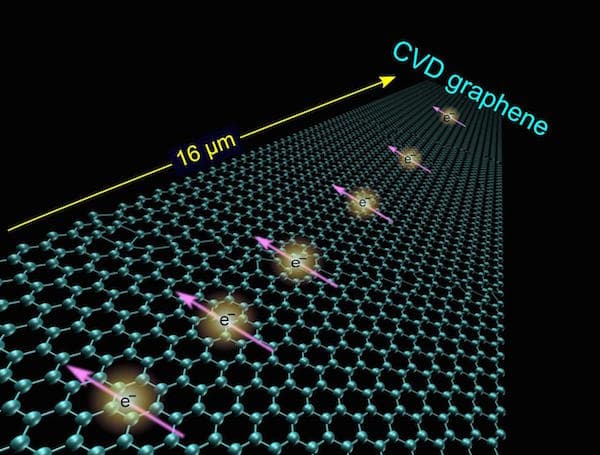Spintronic Devices To Benefit From Graphene - Chalmers University
In solid state devices, the study of electron's spin manipulated by both magnetic and electric fields is known as Spintronics or Spin Electronics. This technology is already being used to create advanced data storage memory devices. An engineering research group from Chalmers University of Technology at Sweden seems to have uncovered a concept that leads the use of Graphene, an allotrope of Carbon, to develop Spintronics in a way that could help us develop highly efficient processing and memory devices in future computers. Their recent research work suggest that Graphene can preserve the spin of electrons over an extended period of time as well as communicate it to bigger distances than what was possible till date.
Led by Saroj Dash, the team of researchers from Chalmers University believe that the greater the use of spintronics in our electronic devices, the faster and lesser energy consuming electronics can be developed. Therefore, they set out to explore the possibilities of Graphene, a superior conductor of electricity, as a carrier of information and not just electric charges. The thin sheet of graphene can be used to make electrons travel several tens of micrometers so that future spin-based devices can be developed. The team used chemical vapour deposited (CVD) Graphene for their experiments which gave the material various defects and made it rough. Using the large area graphene, the research group can demonstrate 6 times higher parameters of spin as compared to any other CVD graphene on a similar substrate.

Demonstration: Using Graphene, electron spin represented by pink arrows and the magnetization last much longer than they do in ordinary conductors such as copper and aluminum.
If a suitable method of manufacturing is developed, this research work suggests that the spin parameters can be improved further. The team is now working on developing a completely new method of performing logical operations & storing information in spintronic devices. This means that instead of switching on and off as operations (0 and 1) in traditional electronic devices, the spintronic devices that can be controlled using electron's up or down spin orientations could come to life.
The entire electronics community would love to see a logical component built out of graphene and magnetic materials and the team's short term goal is just that. That said, we have to admit that replacing semiconductor devices with spintronics technology seems like a far-fetched idea for now, but at least the topic is now on the table for discussion and debate.
What are your thoughts about spintronics devices and the future of electronics? Share with us in comments below.
Source: #-Link-Snipped-#
Led by Saroj Dash, the team of researchers from Chalmers University believe that the greater the use of spintronics in our electronic devices, the faster and lesser energy consuming electronics can be developed. Therefore, they set out to explore the possibilities of Graphene, a superior conductor of electricity, as a carrier of information and not just electric charges. The thin sheet of graphene can be used to make electrons travel several tens of micrometers so that future spin-based devices can be developed. The team used chemical vapour deposited (CVD) Graphene for their experiments which gave the material various defects and made it rough. Using the large area graphene, the research group can demonstrate 6 times higher parameters of spin as compared to any other CVD graphene on a similar substrate.

Demonstration: Using Graphene, electron spin represented by pink arrows and the magnetization last much longer than they do in ordinary conductors such as copper and aluminum.
If a suitable method of manufacturing is developed, this research work suggests that the spin parameters can be improved further. The team is now working on developing a completely new method of performing logical operations & storing information in spintronic devices. This means that instead of switching on and off as operations (0 and 1) in traditional electronic devices, the spintronic devices that can be controlled using electron's up or down spin orientations could come to life.
The entire electronics community would love to see a logical component built out of graphene and magnetic materials and the team's short term goal is just that. That said, we have to admit that replacing semiconductor devices with spintronics technology seems like a far-fetched idea for now, but at least the topic is now on the table for discussion and debate.
What are your thoughts about spintronics devices and the future of electronics? Share with us in comments below.
Source: #-Link-Snipped-#
Replies
You are reading an archived discussion.
Related Posts
My bike has took me some 25,000 kms. I have seen many cuts in my vehicle's rear tyre. I was suggested to change it due to regular punctures.
Unfortunately, manufacturer...
Mumbai-based company iBall has a good collection of Android phones under its Andi series. The newest addition to the iBall Andi series is a new Dual SIM phone that supports...
When it comes to the topic of quantum computing, the world is mesmerized at the moment. As researchers steadily share their research work one after the other, the picture is...
name: vignesh
occupation: student
branch: electrical and electronics engineering
hobbies: to explore science and apply it to make miracles
I joined crazy engineers because: I thought this was a fun...
Fujitsu has announced an innovative liquid cooling heat pipe that can be deployed in compact electronic devices like smartphones or tablets. Liquid cooling systems have existed for desktop class personal...
